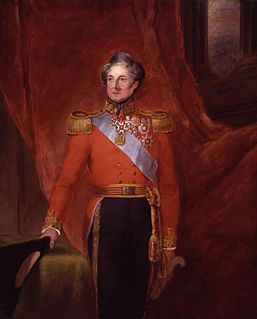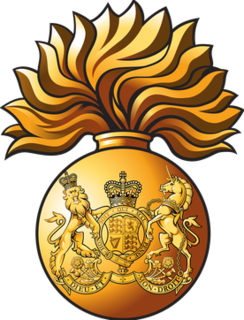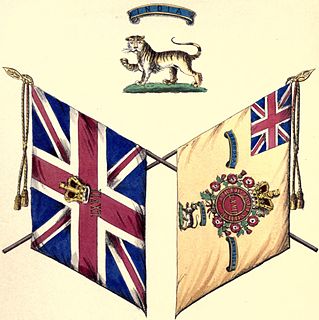The 96th Regiment of Foot was a British Army regiment, raised in 1798. Under the Childers reforms it amalgamated with the 63rd Regiment of Foot to form the Manchester Regiment.

General Sir Colin Halkett was a British Army officer who became Lieutenant Governor of Jersey.

The Royal Scots Fusiliers was a line infantry regiment of the British Army that existed from 1678 until 1959 when it was amalgamated with the Highland Light Infantry to form the Royal Highland Fusiliers which was later itself merged with the Royal Scots Borderers, the Black Watch, the Argyll and Sutherland Highlanders and the Highlanders to form a new large regiment, the Royal Regiment of Scotland.
The 89th Regiment of Foot was a regiment of the British Army, raised on 3 December 1793. Under the Childers Reforms the regiment amalgamated with the 87th Regiment of Foot to form the Princess Victoria's in 1881.

Lieutenant-General Sir William Stewart, GCB was a British military officer who was the first Commanding Officer of the Rifle Corps, a Division Commander in the Peninsular War and a Scottish Member of Parliament (MP) in the British Parliament.

The 73rd Regiment of Foot was an infantry regiment of the British Army, raised in 1780. Under the Childers Reforms it amalgamated with the 42nd Regiment of Foot to form the Black Watch in 1881.
The 35th Regiment of Foot was an infantry regiment of the British Army, raised in 1701. Under the Childers Reforms it amalgamated with the 107th Regiment of Foot to form the Royal Sussex Regiment in 1881.

The 31st (Huntingdonshire) Regiment of Foot was an infantry regiment of the British Army, raised in 1702. Under the Childers Reforms it amalgamated with the 70th (Surrey) Regiment of Foot to form the East Surrey Regiment in 1881.
Field Marshal Sir John Forster FitzGerald, GCB, was a soldier from Ireland who served as an officer in the British Army. He fought in the Peninsular War, seeing action at the Battle of Badajoz, the Battle of Salamanca and the Battle of Vitoria and commanding a brigade during the Battle of the Pyrenees before being captured by the French Army. He became Commandant of Quebec and then went on to be Commandant of Montreal, Quebec. He was given command of the 20th Regiment of Foot in Bombay before being given a divisional command in the Madras Army but shortly afterwards transferring to Bombay where he was given a divisional command of the Bombay Army. He later became a Liberal Member of Parliament.

The 67th Regiment of Foot was a line infantry regiment of the British Army, raised in 1756. Under the Childers Reforms it amalgamated with the 37th Regiment of Foot to form the Hampshire Regiment in 1881.
The 69th Regiment of Foot was an infantry regiment of the British Army, raised in 1756. Under the Childers Reforms it amalgamated with the 41st (Welch) Regiment of Foot to form the Welch Regiment in 1881.

The 87th Regiment of Foot was an infantry regiment of the British Army, raised in 1793. Under the Childers Reforms it amalgamated with the 89th Regiment of Foot to form the Princess Victoria's in 1881.

Hon. Sir Galbraith Lowry Cole, was an Anglo-Irish British Army general and politician.
The 58th (Rutlandshire) Regiment of Foot was a British Army line infantry regiment, raised in 1755. Under the Childers Reforms it amalgamated with the 48th (Northamptonshire) Regiment of Foot to form the Northamptonshire Regiment in 1881.
The 62nd (Wiltshire) Regiment of Foot was an infantry regiment of the British Army, which was raised in 1756 and saw service through the eighteenth and nineteenth centuries. Under the Childers Reforms it amalgamated with the 99th (Lanarkshire) Regiment of Foot to form the Wiltshire Regiment in 1881.
The 85th Regiment of Foot was a British Army line infantry regiment, raised in 1793. Under the Childers Reforms it amalgamated with the 53rd (Shropshire) Regiment of Foot to form the King's Shropshire Light Infantry in 1881.

General Sir Brent Spencer was an Anglo-Irish officer in the British Army, seeing active service during the American Revolutionary War and the French Revolutionary Wars. During the Peninsular War he became General Wellesley's second-in-command on two occasions. He fought at Vimeiro and testified in Wellesley's favour at the inquiry following the Convention of Cintra. He led a division at Bussaco and two divisions at Fuentes de Onoro. After the latter action, he had an independent command in northern Portugal. Wellesley, now Lord Wellington, was not satisfied that Spencer was up to the responsibilities of second-in-command and he was replaced by Thomas Graham. Miffed, Spencer left Portugal and never returned. He became a full general in 1825.

Lieutenant General Sir John Macdonald GCB was Adjutant-General to the Forces.

Sir Adam Ferguson (1770–1854) was deputy keeper of the regalia in Scotland.
General George Henry Vansittart was a British Army officer during the Napoleonic Wars.










